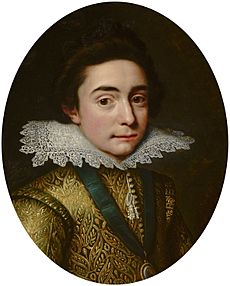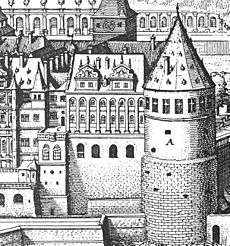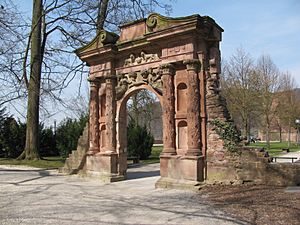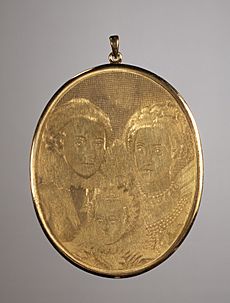Elizabeth Stuart, Queen of Bohemia facts for kids
Quick facts for kids Elizabeth Stuart |
|
|---|---|
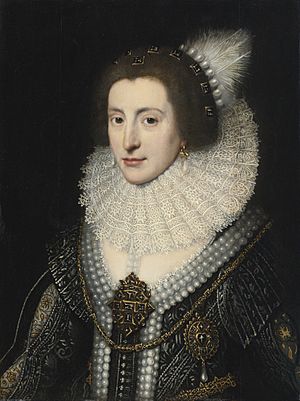
Portrait by the Workshop of Michiel Jansz. van Mierevelt, c. 1623
|
|
| Electress consort of the Palatinate | |
| Tenure | 14 February 1613 – 23 February 1623 |
| Queen consort of Bohemia | |
| Tenure | 4 November 1619 – 8 November 1620 |
| Coronation | 7 November 1619 |
| Born | 19 August 1596 Dunfermline Palace, Fife, Kingdom of Scotland |
| Died | 13 February 1662 (aged 65) London, Kingdom of England |
| Burial | 17 February 1662 Westminster Abbey, London |
| Spouse | |
| Issue |
See
Henry Frederick, Electoral Prince of the Palatinate
Charles I Louis, Elector Palatine Elisabeth, Princess-Abbess of Herford Prince Rupert, Duke of Cumberland Prince Maurice Louise Hollandine, Abbess of Maubuisson Prince Louis Prince Edward, Count Palatine of Simmern Princess Henriette Marie Prince Philip Frederick Princess Charlotte Sophia, Electress of Hanover Prince Gustavus Adolphus |
| House | Stuart |
| Father | James VI and I |
| Mother | Anne of Denmark |
Elizabeth Stuart (born August 19, 1596 – died February 13, 1662) was a princess who became the Electress of the Palatinate. She was also briefly the Queen of Bohemia. She earned the nickname "Winter Queen" because her husband's rule in Bohemia lasted only one winter.
Elizabeth was the second child and oldest daughter of James VI and I. He was the King of Scotland, England, and Ireland. Her mother was Anne of Denmark. Elizabeth's grandson, George I of Great Britain, became the King of Great Britain in 1714. This happened because the last Stuart monarch, Anne, Queen of Great Britain, had no children who survived her. George I started the House of Hanover royal family.
Contents
Early Life of Elizabeth Stuart
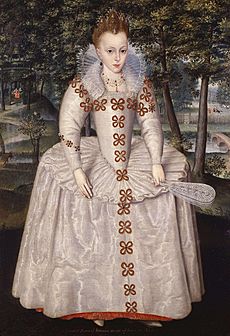
Elizabeth was born at Dunfermline Palace in Scotland on August 19, 1596. Her father, King James, was the King of Scotland at the time. He was not yet the King of England. She was named after her godmother, Elizabeth I of England.
As a young child in Scotland, Elizabeth lived at Linlithgow Palace. She was cared for by Lord and Lady Livingstone. She was very close to her older brother, Henry Frederick, Prince of Wales.
Moving to England
In 1603, Elizabeth I of England died. Elizabeth Stuart's father, King James, became the King of England and Ireland. Elizabeth traveled south to England with her mother. It was a grand journey with many celebrations.
The royal children were moved to Oatlands Palace because of a plague in London. Later, Elizabeth was placed in the care of Lord and Lady Harington at Coombe Abbey. There, she met Anne (Dudley) Sutton, who became a lifelong friend.
The Gunpowder Plot
In 1605, a group of people planned the Gunpowder Plot. They wanted to kill King James and other Protestant leaders. They also planned to kidnap nine-year-old Elizabeth from Coombe Abbey. Their goal was to make her the Catholic Queen of England.
The plotters chose Elizabeth because she was old enough to take part in ceremonies. They believed her older brother, Henry, would die with their father. The plot failed when Guy Fawkes was caught before he could light the gunpowder.
Elizabeth's Education

Elizabeth received a very good education for a princess of her time. She learned about nature, geography, and religion. She also studied languages, writing, music, and dancing. Her father did not want her to learn Latin. He thought it made women "more cunning."
By age 12, Elizabeth spoke several languages, including French. She was also an excellent horse rider. She understood the Protestant religion well. Elizabeth was also very good at writing letters. She loved books and reading.
Courtship and Marriage
As the daughter of a king, many princes wanted to marry Elizabeth. These suitors came from all over Europe. Her marriage was important for her father's kingdom. It was a way to gain power and make alliances in Europe.
Elizabeth's choice of husband was not about her personal feelings. It was about what would benefit England. Most suitors were rejected for various reasons. Some were not high-ranking enough. Others were from countries at war with Denmark, her mother's home country. Her husband also had to be a strong Protestant.
The chosen husband was Frederick V, Elector Palatine. He came from a very important family. His ancestors included kings and dukes. He was also a strong supporter of the Protestant faith.
Their Courtship
Frederick arrived in England on October 16, 1612. He and Elizabeth seemed to like each other right away. People noticed that Frederick enjoyed being with Elizabeth. He also became friends with her brother, Prince Henry, which made Elizabeth very happy.
King James saw the marriage as a way to bring peace in Europe. Elizabeth's mother, Queen Anne, was not happy with the match. She felt Frederick was not important enough for her daughter.
On November 6, 1612, Prince Henry died. This was very sad for Elizabeth. His death also made her even more important. She was now second in line to the throne. Queen Anne and others tried to stop the marriage. But Elizabeth stood by Frederick. He was seen as a future leader for Protestants in Germany.
Marriage to Frederick V
The wedding took place on February 14, 1613, at the royal chapel in Palace of Whitehall. It was a very grand event. Many royals visited England for the occasion. The marriage was very popular with the public. People described the ceremony as "a wonder of ceremonial and magnificence."
The celebrations were very expensive, costing nearly £50,000. This almost made King James go bankrupt. Many writers celebrated the event. One writer said England was "lending her rarest gem, to enrich the Rhine."
Electress Palatine
After almost two months of celebrations in London, Elizabeth and Frederick traveled to Heidelberg. This was where Frederick's court was located. Their journey was full of meetings, food, and entertainment. Elizabeth was expected to give gifts at each stop. She even had to use her own jewelry to get money for presents.
Elizabeth's arrival in Heidelberg was a big event. It showed that the Palatinate was becoming important in European politics. Frederick made many changes to Heidelberg Castle for her. Between 1610 and 1613, he built the Englischer Bau (English Building). He also created a monkey-house, a zoo, and a new garden. This garden, called the Hortus Palatinus, was considered the "Eighth Wonder of the World."
Elizabeth and Frederick were truly in love. They remained a loving couple throughout their marriage. However, there were some challenges. Before they left England, King James made Frederick promise that Elizabeth would be treated like a queen. This meant she would have a higher rank than Frederick's mother, Countess Louise Juliana of Nassau. This made their relationship difficult.
Elizabeth gave birth to three children in Heidelberg:
- Henry Frederick, Hereditary Prince of the Palatinate (born 1614)
- Charles I Louis, Elector Palatine (born 1617)
- Elisabeth of the Palatinate (born 1619)
Queen of Bohemia
In 1619, Elizabeth's husband Frederick was offered the throne of Bohemia. The Kingdom of Bohemia was a country where nobles elected their king. It had a long history of religious freedom. However, the new heir, Archduke Ferdinand, was a strong Catholic. He had treated Protestants badly in his own lands.
The Bohemian nobles decided to remove Ferdinand as king. They invited Frederick to be their new king. Frederick was unsure, but Elizabeth encouraged him. She told him it was his duty as a prince and a Christian.
The family moved to Prague. Frederick was crowned King of Bohemia on November 4, 1619. Elizabeth was crowned Queen of Bohemia three days later. Their third son, Prince Rupert of the Rhine, was born in Prague a month after the coronation.
Frederick's rule in Bohemia started well, but it only lasted one year. The Habsburg family, who Ferdinand belonged to, would not give up Bohemia. Frederick's reign ended when the Bohemian Protestant armies were defeated. This happened at the Battle of White Mountain on November 8, 1620. This battle started the Thirty Years' War.
Elizabeth is remembered as the "Winter Queen." Frederick is known as the "Winter King." These names refer to how short their time as rulers was. They also refer to the season when the battle took place.
Life in Exile
Elizabeth feared the worst after the defeat. She had already left Prague and was waiting for her fifth child to be born. On January 6, 1621, she gave birth to a healthy son, Maurice of the Palatinate.

The family could not return to Prague or the Palatinate. Both places were now controlled by Catholic forces. So, they moved to The Hague in the Netherlands.
Elizabeth arrived in The Hague in the spring of 1621. She felt it was her duty to help her husband. She became a very strong partner in their marriage. While in exile, Elizabeth had eight more children.
Frederick became ill in October 1632. He died on November 29, 1632, before reaching The Hague.
Widowhood
When Elizabeth heard about Frederick's death, she was overcome with sadness. For three days, she did not eat, drink, or sleep. Her brother, King Charles I, invited her to return to England. But she refused. She wanted to fight for her son Charles I Louis, Elector Palatine's rights to the Palatinate.
Elizabeth stayed in The Hague even after her son regained the Palatinate in 1648. She supported artists and ordered a large family portrait. This portrait honored her and her husband.
Elizabeth spent her time writing many letters. She also arranged marriages for her children. Between Frederick's death in 1632 and her own death 30 years later, she saw four more of her children die. Her brother, Charles I of England, was executed in 1649. The Stuart family was forced into exile during the time of the Commonwealth of England. Elizabeth's relationships with her surviving children became distant. She began to think about returning to England.
Death
In 1660, the Stuart family was brought back to the thrones of England, Scotland, and Ireland. This happened with Elizabeth's nephew, Charles II of England. Elizabeth arrived in England on May 26, 1661. She decided to stay and had her belongings sent to her.
She moved into Drury House and then Leicester House, Westminster. By this time, she was very ill. Elizabeth caught pneumonia. She died shortly after midnight on February 13, 1662.
Her death did not cause much public attention. By then, she was mainly known as the mother of Prince Rupert of the Rhine. He was a famous general. On February 17, her coffin was taken to Westminster Abbey. She was buried there among her ancestors, near her beloved brother, Henry.
Elizabeth's Children
Elizabeth and Frederick had 13 children. Six of them lived longer than their mother:
- Henry Frederick, Hereditary Prince of the Palatinate (1614–1629); he drowned.
- Charles I Louis, Elector Palatine (1617–1680); he married and had children.
- Elisabeth of the Palatinate (1618–1680)
- Rupert, Count Palatine of the Rhine (1619–1682); he had two children outside of marriage.
- Maurice of the Palatinate (January 16, 1621 – September 1, 1652)
- Louise Hollandine of the Palatinate (April 18, 1622 – February 11, 1709)
- Louis (August 21, 1624 – December 24, 1624)
- Edward, Count Palatine of Simmern (1625–1663); he married and had children.
- Henriette Marie of the Palatinate (July 7, 1626 – September 18, 1651); she married Prince Sigismund Rákóczi.
- John Philip Frederick of the Palatinate (September 26, 1627 – February 16, 1650)
- Charlotte of the Palatinate (December 19, 1628 – January 14, 1631)
- Sophia, Electress of Hanover (October 14, 1630 – June 8, 1714); she married and had children, including King George I of Great Britain. Many royal families today are descendants of Sophia and Elizabeth. Sophia almost became Queen of Great Britain but died two months before Anne, Queen of Great Britain.
- Gustavus Adolphus of the Palatinate (January 14, 1632 – 1641)
Elizabeth's Legacy
The English Act of Settlement 1701 decided who would inherit the English and Scottish crowns. It stated that Elizabeth's youngest daughter, Sophia of Hanover, and her children would be next in line. In August 1714, Sophia's son, George I of Great Britain, became king. This means that the future British Royal family are all descendants of Elizabeth.
The Elizabeth River (Virginia) in Virginia, USA, was named after Princess Elizabeth. So was Cape Elizabeth, Maine. John Smith (explorer) explored and mapped New England. He suggested to King Charles I that he change the Native American names to English ones. The king made many changes, and Cape Elizabeth is one of the four names that still exist today.
Legend says that William Craven, 1st Earl of Craven (1608–1697), built Ashdown House, Oxfordshire in England to honor Elizabeth. However, she died before the house was finished.
Images for kids
-
Triumph of the Winter Queen: Allegory of the Just, 1636, by Gerard van Honthorst.
-
Elizabeth Stuart as a Widow, 1642, by Gerard van Honthorst.
See also
 In Spanish: Isabel Estuardo para niños
In Spanish: Isabel Estuardo para niños



